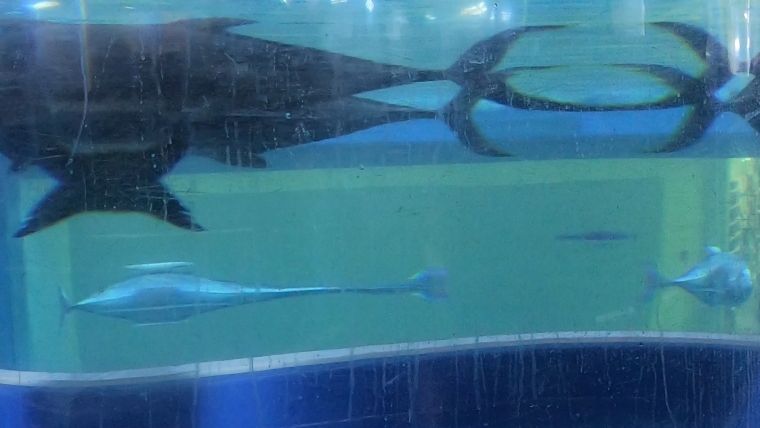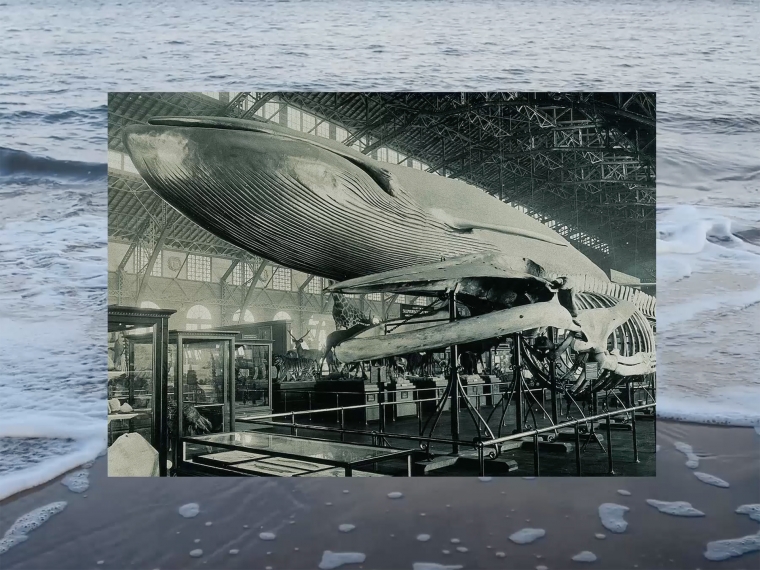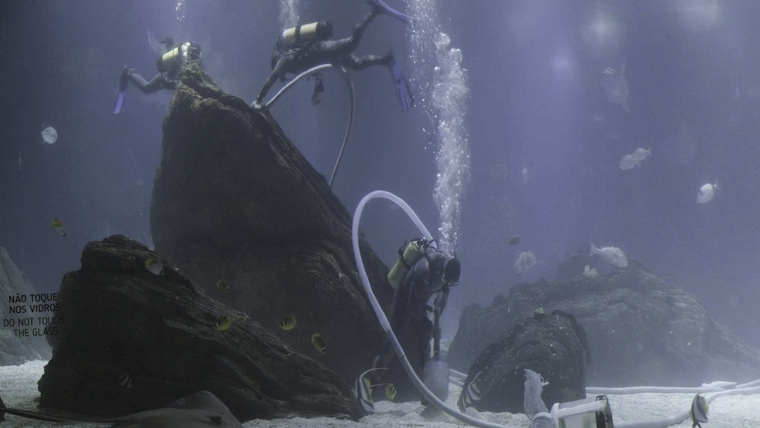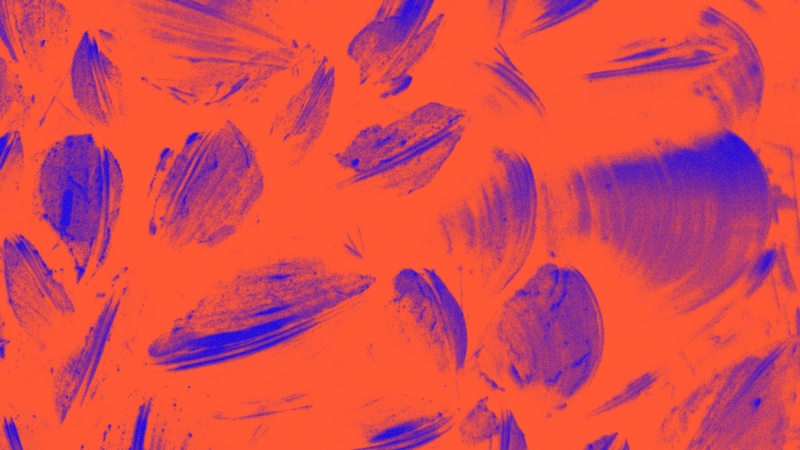The Eightfold Way
Notes on Floating in Water and Air
Daniela Zyman
“Imagine you are falling. But there is no ground.” 1
◉
The littoral connects to the ocean surface and dissolves in the distant horizon line. When viewed from land, the ocean offers a grounded Terran perspective. Its surface has been mapped and gridded for navigation and mastery over the elemental. The superficies indicate an expanse but suggest a groundless depth, the abyss. And yet below the plane expanse, the ocean problematises literacy and poses a challenge to geography, the writing of the earth. The epistemology of the line, which has been impressed onto the land inevitably dissolves in water.
Below the surface, altered forces and properties act upon bodies: different atmospheric pressure, temperatures, oxygenation, light refraction, salination and sonic dispersal. In water, bodies circulate, levitate, float, drift and drown. Disorientation sets in as sensory stimuli (visual, vestibular and proprioceptive) change in magnitude, direction and frequency. The pelagic is a realm humans can only access, ever so temporarily, via immersion, bodily and machine-aided submersion.
-
(1) Hito Steyerl, “In Free Fall: A Thought Experiment on Vertical Perspective,” e-flux journal 24, April 2011. Available here (accessed July 2021).
Everard Digby, in “De Arte Natandi”, 1587 (CC). Swimming was “forgotten” in Western Europe in the late Antiquity. The return to swimming was a slow process that only began in the 16th century with Everard Digby (c. 1550-1605), fellow of St John’s College, Cambridge, DIY treatise: “… without doubt Man would not only Swim naturally like other Creatures, but also in more Perfection, and with more Variety, both for Pleasure and Advantage.”
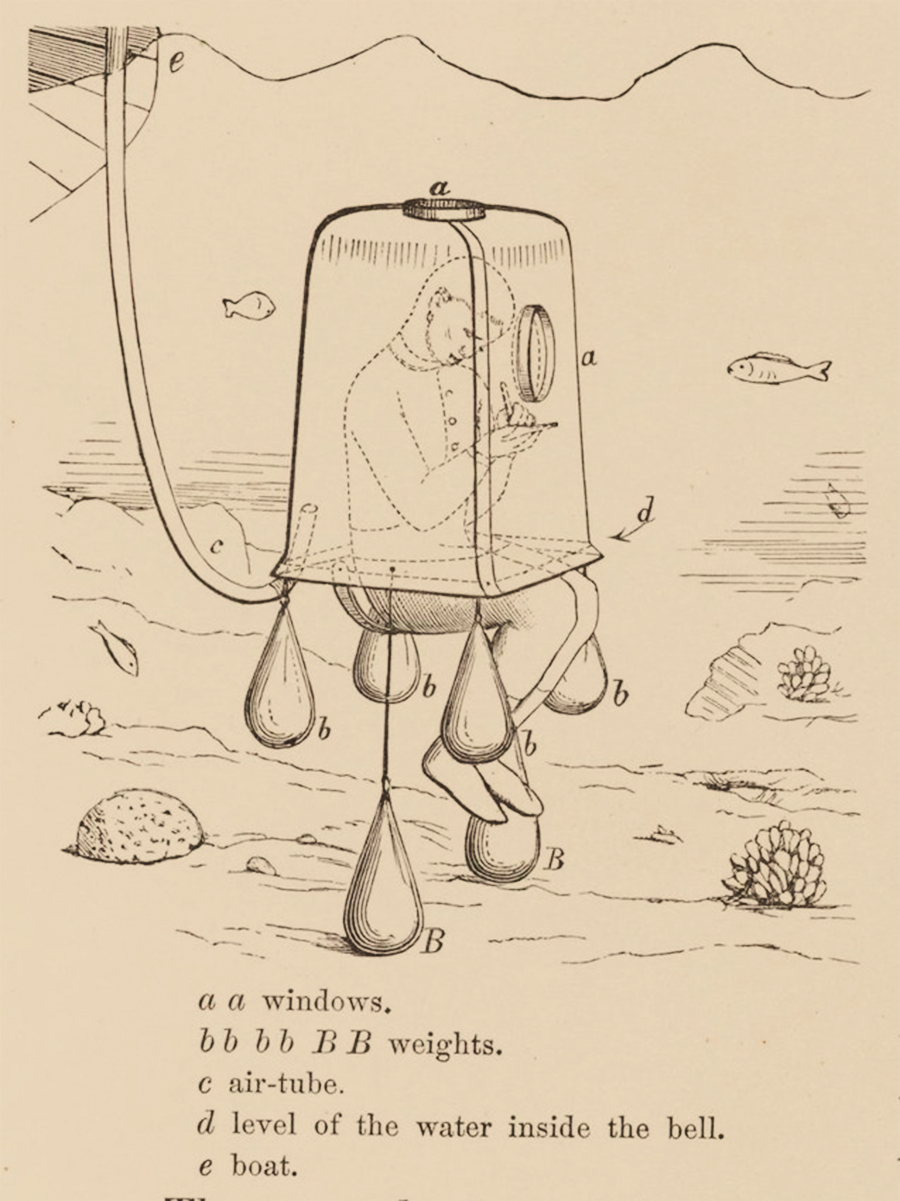
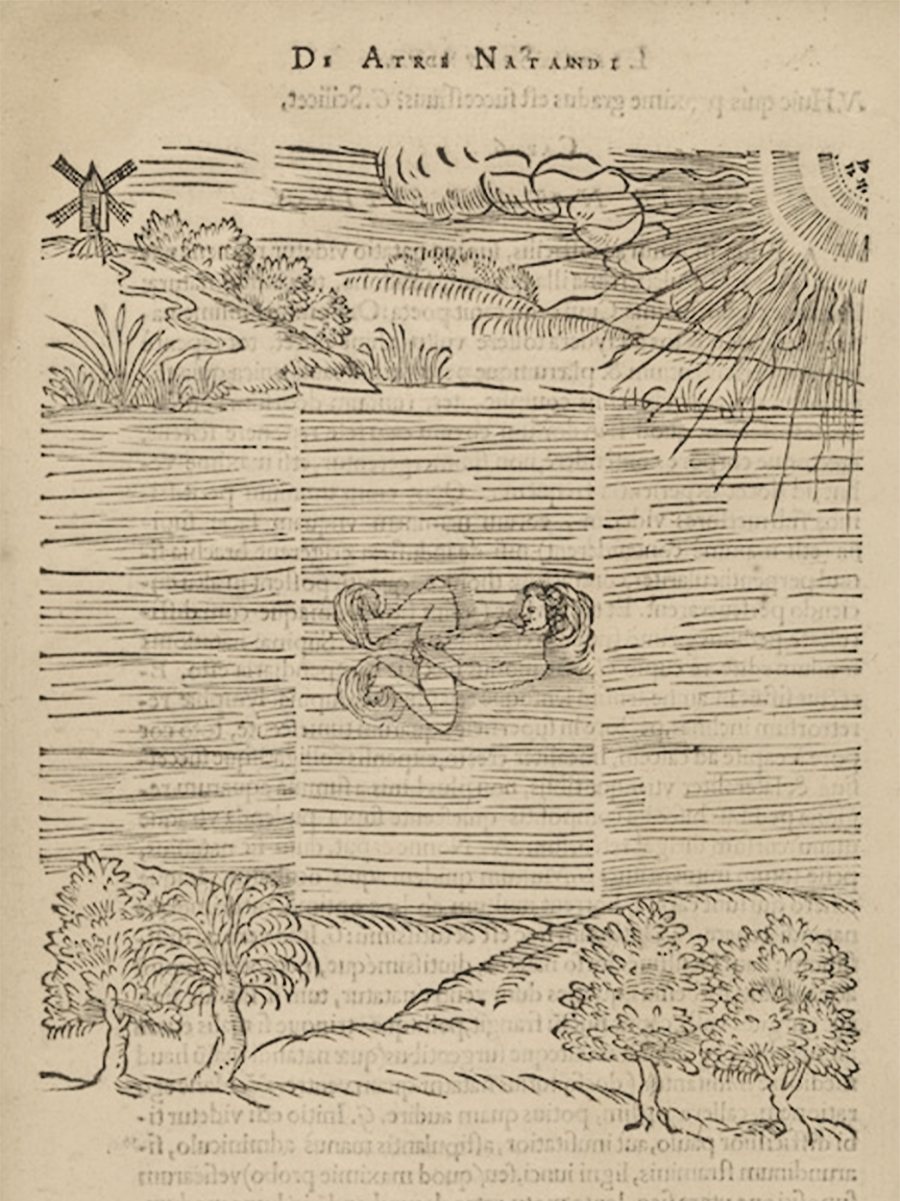
Eugen Ransonnet-Villez, from “Sketches of the Inhabitants, Animal Life and Vegetation in the Lowlands and High Mountains of Ceylon: As Well as of the Submarine Scenery near the Coast Taken from a Diving Bell”, 1867 (CC).
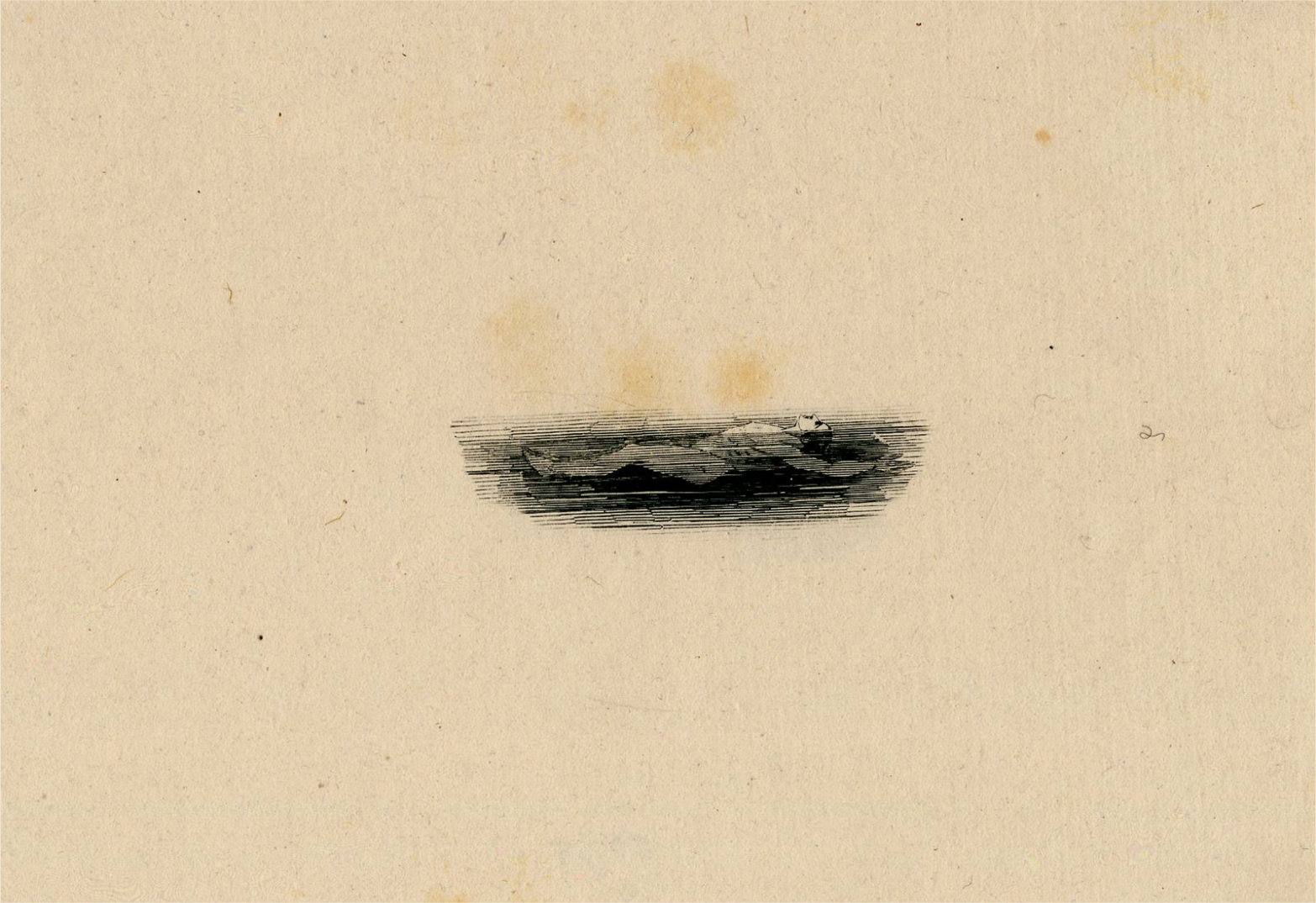
Samuel Williams, “A boy swimming on his back towards the right, without resting the head”, proof illustration to J. L. Williams' “Every Boy's Book” (London: Dean & Munday, 1841 (British Museum, CC).
One gift, among many others, offered by the ocean’s deep waters is the agitated reflexivity it affords the world. “The liquid, impermanent, and unstable gift of similarity” (→ 2) allows us to see the world again, reversed, upside-down, from below, in movement and dissolution. It is indeed intriguing and highly elucidating to “see” from water. It is politically and intellectually challenging to leave behind the solid grounds from where we learned both to walk and re-flect concepts and ideas. To drift away from the continental landmass and consider the dis/similarities and trans/correspondences of the aquatic is ethically and ontologically unmooring.
From below and in the below, water’s otherness takes hold of the body and theorisation. Water, so it seems to me at times, is an intoxicating elixir conducive to onto-feminist scheming. As our grounded epistemologies crumble, and perhaps irreparably collapse, the oceans offer a generous surplus to think with. Island literature and theory; oceanic humanities; hydrofeminism; wet ontologies; and indigenous epistemologies (to name a few confluent areas of study and writing from which thinking has recently experienced a sea change) have all pointed to the vast potentialities arising from the unknown abyssal depths.
The interconnectedness of all life in water is tangible, tacit, visible, graspable. Water, other than air, is a palpable medium of relation. Water conducts, also dilutes, and conceals. It can last hundreds of thousands of years (in ice), holding particles and toxins in suspension before releasing them into the hydrological cycle. For the very reason that the ocean is pure connectivity – constantly redefined by more or less governable patterns of mobility, human enterprise, and more-than-human assemblages – thinking with the oceans can be likened to turbulence, an undisciplined form of knowledge that tosses body and mind around and never comes to rest.
-
(2) Alice Oswald, “Interview with Water,” available here (accessed July 2021).
The ocean moves in diffraction, performing in capacious cycles a kind of folding onto itself that makes each wave be in many places at the same time. Karen Barad calls the property of diffraction “self-touching,” or rather self-embracing I would suggest, “like the Marshallese indigenous practice of wave-piloting, riding the diffraction patterns of difference/differencing/différancing guiding us along alternative paths, transformative alchemical wanderings/wonderings.” (→ 3)
Unknowability deeply unmoors the will to know. Science and Western epistemology are deeply irritated and provoked by all that is not yet known. The unknown is considered a temporal dark spot, a provocation eventually made to disappear through technological innovation, cooperation and capitalization. Extremophile organisms, unimaginably strange, living in extreme depths and under the most alien conditions, are classified by the Ocean Census. The hadal and abyssal ocean floor is being 3D scanned with powerful multi-beam echo-sounder systems, to deliver fully downloadable bathymetries by 2030. The morphology of the polar ice sheets is being gridded and mapped. These are but some examples of oceanic unknowns waiting (or not) to be discovered, imaged and archived.
Martinique thinker Édouard Glissant invokes the “right to opacity,” against what he calls the “barbaric imposition” of transparency. He claims, “There’s a basic injustice in the worldwide spread of the transparency and projection of Western thought.” He goes on to say: “Why must I absolutely understand the Other in order to live next to him and work with him? That’s one of the laws of Relation. In Relation, elements don’t blend just like that, don’t lose themselves just like that.” (→ 4) Unknowability is the prerequisite to otherness.
-
(3) Karen Barad, “After the End of the World: Entangled Nuclear Colonialisms, Matters of Force, and the Material Force of Justice,” Theory & Event 22, no. 3 (July 2019): 524–50.
-
(4) Édouard Glissant, Manthia Diawara, and Christopher Winks, “Édouard Glissant in Conversation with Manthia Diawara,” Nka: Journal of Contemporary African Art, Duke University Press, no. 28, 2011 (n.d.): 4–19.
Sulculeolaria quadrivalvis, a deep-sea siphonophore living most likely in all the world’s oceans. A siphonophore is a colony of co-working organisms whose internal dramaturgy allows them to live together as if just one. They are so puzzling that scientists use complex orientational diagrams to describe their internal distributions and organisations. Photo: by Jeff Molder.

◉
What has worried me for a while now is how to engage the agitated thinking of groundlessness, connectivity and fallenness both outside of the metaphoric and specifically oceanic, without committing to a dubious “politics of authenticity,” mediated by the dissolution into an idealised natural environment. I have been working on ways to deploy the affective and sensory repertoire of the aquatic beyond its medium-specific environment and make use of a non-hierarchical imaginary, while attempting to negotiate the conflicts between the incommensurate unknowability of ecology and nature, and politics and injustice. Inadvertently reinstituting either an oceanic unity or predicated divisions feels untenable.
This is when I was introduced to the book-long, single-line poem Be Holding by the American writer Ross Gay, published in 2020. Be Holding is a book about a singular move of an exceptional athlete, the legendary basketball player Julius Erving, byname Dr. J (or The Doctor) who defied gravity on the court and beyond it. It is a poem that tries to be a basketball game, performing unpredictable verbal shots and hypnotic manoeuvres. Written in rapid-motion, two-line stanzas, elusively cascading down the book page, it performs a lyrical trans-substantiation of a 16-second baseline scoop move by Dr. J in the 1980 NBA finals.
Be Holding has unlocked for me the ways in which the words to hold, to be holding, to behold, the beholden, the ships’s hold and Haltung (the German word for position, both physical and ethical), all originating from one etymological well, haldan (holding), can be mobilized to think with bodies in suspension and how suspended bodies burst into spaciousness and arrest the motion of time. How the body in flight and fallenness escapes – for 16-seconds perhaps – the violence, the predator’s gaze of violence that otherwise inscribes itself onto his prey’s carnal flesh. And how Gay’s arcing attention and locomotive language decomposes the minutiae of seeing, and subsequently the act of writing, and reading into constellations of spinning and floating particles.
These 16-seconds, relentlessly rewound on Youtube, as Gay details, and magnetically held whirling in the air, have occasioned the following reflections by Fred Moten. Needless to say, they are in themselves a poem on seeing, holding, handing, and word-ing.
"Nothing happens only when it happens. Right now, we're all tree-borne watching the Doctor all but not come down, again and again. We feel the weight of our enjoyment, the heavy duress we're under when it happens, where it happens, where nothing happens only where it happens. Behold! We are held in flight. Is that why Dr. J tried to give the last word on that move, saying it was 'just another move,' saying so all but sadly? Well, Be Holding unfolds that word, moves it and releases it, re-releasing that move in carefully watching, again and again, for all that differentiates it from all the descendant moves and for all that entangles it with all the ascendant ones. The flights in fallenness, the grave plays on stillness, the refusals of space and time, the reprovals of being and history, are so serious that it's as if it were just a game, not a game, not a game, this practice of desperate falling into looking. We play it light, though. There's no last word on what we hand and hold, or on what we behold, or on our beholding. Again and again, in the beautiful note he holds and hands, that's what Ross Gay be saying." (→ 5)
Gay’s Be Holding is an exercise in deep looking, or rather beholding in the sense of to hold, preserve, gaze on. It is about bearing witness, when and only if the act of witnessing is understood with all its biases and can resist extractive authority. A kind of looking against the regimes of visuality, or, and I quote again Moten, a “practice of desperate falling into looking.”
“To fall into looking” suggests a holding / Haltung / a position from where to look, and the distinctive ways how to look (or not to look). It is an exercise of falling or rather fallenness, as Moten calls it. Beholding not only emerges against the violence that looking often perpetuates and the pain inflicted on oneself and others by recording acts of violence and annihilation. Well yes, it is an act of desperation as well, but more so, it is a practice and a duty of the beholden, here understood as gratefulness, obligation and indebtedness.
In the mysterious fallenness of looking-as-beholden, there is no finality, closure, nor capture, no syncing up bodies, places and times. Rather it inheres in watery radiance, in the devotional descent into the abyss, wavering wondering, the agitated reflection of the eyes. But which eyes? Not the eyes that are nested in the skull, the directional laser-sharp viewing instruments. Released eyes, external eyes that drift around, light-heartedly. Collaborative eyes, traveling outside of the head, eyes that migrate through the body (as some fish do while changing their positions from upright to flat), or navigate the skies and dive deep into currents, as living beings perhaps.
-
(5) Fred Moten, “Be Holding: A Poem,” Ross Gay's website, 2020, accessed July 2021.
Fallenness irreverently interrupts the productivity of the gaze, its “ineluctable modality” (→ 6) and extractivist allure. Extractivism reeks of the stench of environmental degradation, greed and racism, the expropriation of land and work. The breathing gaze also irritates the “terrestrial bias,” which humans adopted when rising from the oceans. It demands precise labour, the building of muscles, and the practice of gratefulness. It is almost like seeing beyond, but not in the sense of “meta,” the all-seeing eye, but a gaze beyond the field of sight, out of focus even. Or a seeing from below, from under the water’s surface, falling into the unstable world of similarity.
For the beholding witness, violence and its reiteration are no option. As the eye radiantly and alertly falls into the act of sight, it meets no ground, no end, no obstacle. Falling, true falling, is indeed groundless, abyssal, hadal. To hone a falling eye and to understand how sight works in a poem, how seeing and saying constitute poetry in its obligation to the possibilities of the world, we need to understand falling, I would like to suggest, as a hovering manoeuvre of imagination and attention, a reinvention of form, rhythm, and touch in every verse, a moving (forward, sideward, downward…) and a trailing behind that doesn’t get stuck in clauses and accomplishment.
Perhaps, this is what Kafka meant, in the Songs of Sirens, when he wrote: “They [the sirens] no longer had any desire to allure; all that they wanted was to hold as long as they could the radiance that fell from Ulysses’ great eyes.” (→ 7)
-
(6) Nicholas Mirzoeff, The Right to Look: A Counterhistory of Visuality (Durham: Duke University Press, 2011), xiii.
-
(7) Franz Kafka, “The Silence of The Sirens” in The Great Wall of China (London: Penguin Classic, 2007).
Erving simply decided in the air
to knock on other doors
by soaring more
– have you ever decided anything
In the air? – 8
Gay’s falling into looking catches the soaring, reaching, and catapulting of the athlete’s body. Julius Erving, aka Dr. J., was a stellar basketball player of inimitable grace, achieving the impossible in flight and falling. Gay calls it: “The reaching that makes of falling flight.” (→ 9) True falling indeed comes close to floating and flying, effortlessly propelling the body into the air and once up in the air: lingering, moving, walking, even running and deciding. Doc, as he was nicknamed by his cheering fans, was walking on air, with the ball in one hand, windmilling it across the air and soaring like a bird under the blackboard.
As dancers, astronauts and swimmers know, leaving the groundedness of earth, in defiance of gravity is available to humans. Known are the many jumpers, pirouette masters leaping in grande allegro across the dance floor.
-
(8) Ross Gay, Be Holding: A Poem, (Pittsburgh: University of Pittsburgh Press, 2020).
-
(9) Ibid.
and what I cannot help but think
tonight, at 3:33 a.m., a bit dazed, admittedly,
from watching Erving’s move,
again, and again,
is that this
is like looking
at the surface of the water
from below,
is like looking into the sky
through the water’s slow turning above
where you can squint and see bodies
looking down at you, 10
the Doctor gasping finally through
the ghosts of light,
legs splayed into a star,
and when he emerges,
the right hand swoops so low,
a pelican or cormorant
merging with her reflection
in the water,
before pulling the ball slowly,
so slowly, toward the rim,
which involves every single muscle
in his flying body
quivered into a singular
coherence [...]11
**
but tonight forward,
for the turning toward
Doc makes the ball do,
Doc in flight makes the ball do,
Doc in flight decides
to make the ball do,
kissing, let’s call it kissing,
this endless reaching
we do
– breathe –12
-
(10 → 12) Ibid.
Gay’s poem circles the rising/falling star-splayed figure of the Doc only to catch in full flight other bodies and moments from lives past and lives returned. Doc’s flying kiss through the air, while soaring in defiance of gravity is “just another move,” committed to memory and repeated to reach beyond the trauma-machine of anti-blackness. Doc’s impossible moves are moves against the impossible, just as Gay’s watching is seeing beyond seeing.
His words seem to ask, but never really do: “How can I hold and behold the hold of the ship that keeps traversing the Atlantic Ocean, since time immortal, incessantly, and ongoingly” and yet while beholden to the waters in which “there’s a railroad made of human bones,” (→ 13) not to drown in the impossibility of black existence. How to write “presence, not absence not about “presence,” (→ 14) but in the present, through it, affirming through each breath that breathing is possible, in the sky but also in the water. Breath and breathing, and flying and falling, holding and be holding are what binds black consciousness and being to water; and to think despite the hold, we might need to practice, unfailingly, floating and falling. “A practice that spites the hold, that spites the overboard”. (→ 15)
-
(13) Amiri Baraka, Wise, Why’s, y’s, 1st ed. (Chicago, IL: Third World Press, 1995). Available here (accessed July 2021).
-
(14) “The Case for Prison Abolition: Ruth Wilson Gilmore on COVID-19, Racial Capitalism & Decarceration”, Democracy Now!, 2020. Available here (accessed on July 2021).
-
(15) Ross Gay interview with David Naimon, available here (accessed July 2021). The book in general, but especially at this juncture hints at Christina Sharpe’s notion of wake work.
Intro image: photo by Markus Reymann, 2019.
Daniela Zyman is a curator, writer, educator, and yogic amateur. She developed the proposal for “Inter/species Yoga” a few years ago, when invited by the artist group SUPERFLEX to participate in their research expedition in the Pacific. She is artistic director of Thyssen-Bornemisza Art Contemporary (TBA21). Zyman joined TBA21 in 2003 and has played an instrumental role in shaping its exhibitions and commissions programme. She is the curator of Territorial Agency: Oceans in Transformation at Ocean Space, Venice, and Walid Raad’s Cotton under my Feet at Museo Nacional Thyssen-Bornemisza, Madrid.
Inter/species Yoga: A Devotional Exploration in Practice is a performative and collaborative yoga session conducted by Daniela Zyman, which invites to experiment with a series of old and newly imagined poses and dynamic flows that direct Yoga’s “luminous cognition” to animal, vegetal, and mineral entities. Departing from the canonical visualisation of the yogic body and its taxonomy of asanas, “Inter/species Yoga” wishes to reignite our devotional attention and imagination to the forms of being that we model and embody.
The session is presented as part of On Floating, Aquanauts and Liquid Habitats: Pools as Aquaria for Humans, a two-day public programme curated by Barbara Casavecchia for maat and presented in the context of the exhibition Aquaria – Or the Illusion of a Boxed Sea (maat, 18/03 – 06/09/2021), that reflects on the new issues that any rethinking of our relationship with the marine world might come up against. The programme explores how an aquarium for humans could become the conceptual interface through which experiencing, floating and communicating potentially foster new forms of knowing, surpassing the logic of language’s colonisation in knowledge transmission.
“maat Explorations” is an ongoing programme that delves into the socio-cultural and environmental transformations concerning the current bio crisis and ecological destruction, providing insight into the hard science of climate intervention and the creative speculations behind innovation-led research to safeguard our planetary co-existence.
The exhibition Aquaria – Or the Illusion of a Boxed Sea (maat, 18/03 – 06/09/2021) reflects on the possibilities and new questions that arise when rethinking our relationship with the marine world. Curated by Angela Rui, the exhibition path unfolds through 11 installations offering different points of view to emphasise how the ways of understanding the marine environment were once designed and how they should be reconsidered today.





